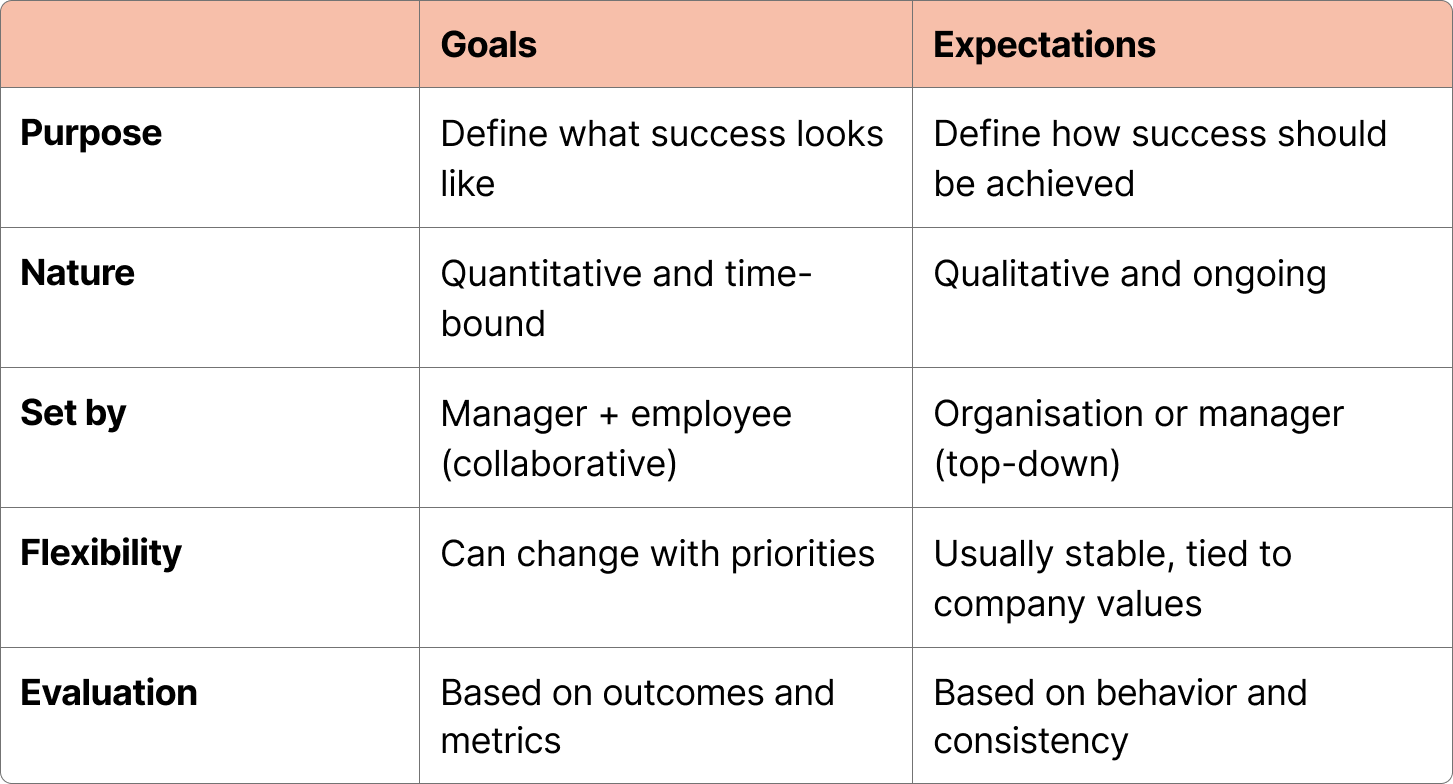Managers often use goals and expectations as if they mean the same thing but they don’t. Goals define what employees should achieve. Expectations shape how they’re expected to act while achieving it.
When teams confuse these concepts, clarity disappears. Employees chase numbers without understanding behavioral standards or they meet expectations without improving performance. According to Gallup, only half of employees clearly understand what is expected of them, this is one of the most significant factors in low engagement and low productivity.
A proper understanding of both concepts turns confusion into consistency and consistency into real results.
What Are Goals?
Goals define what employees are expected to achieve — the tangible, measurable outcomes of their work. They give direction, create focus and make performance visible. Without clear goals, teams drift, but with them, people understand exactly where to invest their effort and how success will be measured.
Effective goals are specific, time-bound, and aligned with business priorities. They direct employees not only to the need for improvement, but also to what exactly needs to be improved, by how much, and by when. This clarity fosters accountability and motivation.
Goals act as roadmaps: they connect daily tasks with strategic results, turning individual work into collective progress.
How to Structure Goals
The most common frameworks are SMART and OKRs:
- SMART goals ensure each objective is Specific, Measurable, Achievable, Relevant and Time-bound.
- OKRs (Objectives and Key Results) combine ambition with measurability.
The structure matters less than the clarity and alignment. Every goal should clearly link an employee’s daily work to the company’s broader objectives.
Types of Goals in Modern Performance Management
Not all goals serve the same purpose.
1. Performance Goals
Performance goals define immediate, job-specific results that an employee must achieve within a specified period. They are quantitative, directly linked to KPIs or OKRs, and are measured using data.
These goals answer the question: What results indicate that the employee is performing their role well?
They give employees a clear performance target and allow managers to measure outcomes objectively.
2. Development Goals
Development goals are about building skills and competencies that prepare employees for future roles or higher performance. They’re often qualitative, focusing on learning, behavior, rather than numeric outcomes.
These goals answer: How will this employee grow in capability this quarter or year?
They create long-term engagement. Employees who feel they’re learning and advancing are far more likely to stay. Research shows that 94% of employees would stay longer at companies that invest in their career development.
3. Managerial or Leadership Goals
Managerial goals focus on leading teams effectively, not just delivering individual results. They combine operational targets with people-focused outcomes such as engagement, communication and development.
These goals answer: How will this manager create conditions for others to succeed?
When managers’ goals include developing others, performance improvement cascades throughout the organization.
4. New-Hire or Onboarding Goals
For new employees, goals should help them understand the business, adapt to the culture and reach productivity quickly. These goals blend performance with learning milestones.
They answer: How will this person become confident, connected and competent in their new role?
A structured onboarding goal plan reduces ramp-up time and increases retention — new hires with clear goals are 58% more likely to stay after three years.
5. Behavioral or Cultural Goals
While not always formally written, behavioral goals define how employees are expected to achieve outcomes linking to company values and expectations.
Expectations: How They Work?
If goals define what employees need to achieve, expectations explain how that work should be done. They set the tone for behavior, communication and collaboration turning company values into daily actions.
Expectations are not one-time targets,they are ongoing standards. They include how employees communicate with others, take ownership of tasks, make decisions, etc. Expectations are like the professional foundation that supports goal achievement — the everyday behaviors that make success possible.
When expectations are clear, employees understand what good work looks like, not just in numbers, but in attitude and approach. According to Gallup, employees who strongly agree they know what’s expected of them are 2.7 times more likely to be engaged at work.
Setting expectations also builds consistency and fairness. It helps managers evaluate performance more objectively, based on both results and behaviors. For example, an employee may hit every goal but damage team trust through poor communication. Clear expectations make this visible and addressable.
Finally, expectations protect well-being. When employees know the boundaries — what’s urgent, what can wait, how decisions are made, they experience less stress and ambiguity. Expectations reduce confusion, strengthen accountability and make collaboration smoother.
How Goals and Expectations Work Together
Goals and expectations are two sides of one system:
- Goals push employees to reach new levels of achievement
- Expectations ensure those achievements happen the right way
If you imagine goals as the destination, expectations are the road rules. You need both to reach success safely and effectively.
When they align, they create a performance culture that’s both ambitious and ethical, focused on results and relationships. Moreover, managers who combine measurable goals with clear expectations report higher engagement and lower turnover.
Key Differences Between Goals And Expectations in Practice

When goals and expectations are clearly defined together, teams become more productive, motivated and aligned. Clarity reduces role ambiguity — one of the biggest drivers of burnout and disengagement.
- Clear goals ensure every employee knows what success looks like
- Clear expectations ensure they understand how to achieve it through collaboration and accountability.
So, together they:
- Build psychological safety (“I know what’s expected of me”)
- Strengthen accountability (“I know what success means”)
- Encourage continuous learning and growth
- Improve performance reviews and career development
How to Apply Them in Your Team
Understanding the difference between goals and expectations is only valuable if it changes how you manage people day to day. Here’s how to bring both concepts to life inside your team in a structured and practical way.
1. Start Every Cycle by Clarifying Both
At the beginning of each performance cycle, make sure every employee knows two things:
- What they need to achieve (their goals)
- How they’re expected to achieve it (their expectations)
Aim for 3–5 clear goals and 3–5 expectations per role. Write them down and share them in your performance management platform or team workspace.
2. Use Both in Check-ins and Performance Reviews
Goals and expectations work better when they’re discussed together. During regular 1:1s or review meetings, talk about both results (what was achieved) and behaviors (how it was achieved). This approach encourages balanced feedback and avoids one-sided evaluations focused only on numbers.
3. Revisit and Adjust Regularly
Goals and expectations are not static.
- Goals should evolve with business priorities — new projects, market changes, etc.
- Expectations tend to stay stable but may need clarification as teams grow or roles change.
Adjusting them together keeps the process fair and reduces frustration.
4. Integrate Goals and Expectations into HR Systems
To make this process sustainable, document everything in one place — ideally within a performance management tool.
Platforms like Okrate allow you to:
- Set and track goals and expectations side by side.
- Record feedback and check-in notes in real time.
- Visualize progress with dashboards and automated reminders.
- Align goals across teams and link them to company goals.
This transparency ensures that goals aren’t forgotten between reviews and expectations remain visible.
Goals and expectations are not rivals, they’re partners. Goals drive achievement, while expectations shape integrity.
When managers clearly define both, employees know exactly where they’re going and what it takes to get there. The result isn’t just higher performance, it’s a culture of trust, accountability and sustainable growth.
